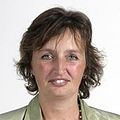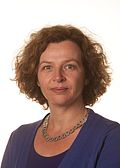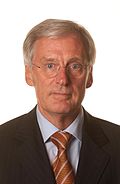First Rutte cabinet
First Rutte cabinet Rutte–Verhagen cabinet | |
|---|---|
Cabinet of the Netherlands | |
  Installation of the cabinet by Queen Beatrix at Huis ten Bosch on 14 October 2010 | |
| Date formed | 14 October 2010 |
| Date dissolved | 5 November 2012 2 years, 22 days in office (Demissionary from 23 April 2012) |
| People and organisations | |
| Monarch | Queen Beatrix |
| Prime Minister | Mark Rutte |
| Deputy Prime Minister | Maxime Verhagen |
| No. of ministers | 12 |
| Ministers removed | 1 |
| Total no. of members | 13 |
| Member party | People's Party for Freedom and Democracy (VVD) Christian Democratic Appeal (CDA) Party for Freedom (PVV) (Confidence and supply) |
| Status in legislature | Right-wing Minority government (Confidence and supply) |
| History | |
| Election | 2010 election |
| Outgoing election | 2012 election |
| Legislature terms | 2010–2012 |
| Incoming formation | 2010 formation |
| Outgoing formation | 2012 formation |
| Predecessor | Fourth Balkenende cabinet |
| Successor | Second Rutte cabinet |
| Part of the Politics series |
![Azure, billetty Or a lion with a coronet Or armed and langued Gules holding in his dexter paw a sword Argent hilted Or and in the sinister paw seven arrows Argent pointed and bound together Or. [The seven arrows stand for the seven provinces of the Union of Utrecht.] The shield is crowned with the (Dutch) royal crown and supported by two lions Or armed and langued gules. They stand on a scroll Azure with the text (Or) "Je Maintiendrai" (French for "I will maintain".)](http://upload.wikimedia.org/wikipedia/commons/thumb/8/8f/State_coat_of_arms_of_the_Netherlands.svg/150px-State_coat_of_arms_of_the_Netherlands.svg.png) |
|---|
|
|
| ||
|---|---|---|
|
Political career
Prime Minister of the Netherlands First Ministry and term Second Ministry and term Third Ministry and term
Fourth Ministry and term Affiliations Media gallery |
||
The first Rutte cabinet, also called the Rutte–Verhagen cabinet was the executive branch of the government of the Netherlands from 14 October 2010 until 5 November 2012. The cabinet was formed by the conservative-liberal People's Party for Freedom and Democracy (VVD) and the Christian-democratic Christian Democratic Appeal (CDA) after the election of 2010. The cabinet was a right-wing coalition and had a minority in the House of Representatives but had confidence and supply from the Party for Freedom (PVV) for a slim majority with Liberal Leader Mark Rutte serving as Prime Minister. Christian Democratic Leader Maxime Verhagen served as Deputy Prime Minister and Minister of Economic Affairs, Agriculture and Innovation.
The cabinet served in the early years of the 2010s. Domestically, it had to deal with the fallout of the financial crisis of 2008 but it was able to implement several major social reforms to law enforcement, victims' rights and immigration. Internationally, it had to deal with the European debt crisis, the war on terror and the government support for the Task Force Uruzgan. The cabinet suffered several major internal and external conflicts because of the confidence and supply construction from the Party for Freedom. The cabinet fell just 18 months into its term on 23 April 2012 after the Party for Freedom withdrew its support following a disagreeing with the coalition over stronger austerity measures to reduce the deficit following the financial crisis. The cabinet continued in a demissionary capacity until it was replaced by the second Rutte cabinet following the election of 2012.[1][2][3]
Formation
[edit]Following the collapse of the fourth Balkenende cabinet on 20 February 2010, elections for the House of Representatives were held on 9 June 2010. As usual in Dutch politics, none of the parties had a majority and several informateurs were appointed to investigate the formation of a coalition cabinet. A broad coalition consisting of the People's Party for Freedom and Democracy (VVD), Christian Democratic Appeal (CDA) and the Labour Party (PvdA) was briefly looked at, but dismissed. Then negotiations for a "purple plus" coalition consisting of the VVD, PvdA, Democrats 66 and GreenLeft lasted for about three weeks, but the parties could not reach agreement on the amount of budget cuts.
Finally, a construction which is rare for the Netherlands was investigated: a minority coalition consisting of the VVD and Christian Democratic Appeal (together 52 out of 150 seats in the House of Representatives), supported in parliament by the Party for Freedom (PVV, 24 seats), to make the smallest possible majority of 76 seats. The right wing PVV had the largest gains in the recent elections.
The stated reason for this construction was that parties agreed that the largest party (the VVD) and the party with the largest gains (considered the 'winner' in Dutch politics) needed to be in power. Only CDA could or wanted to help make a majority, but they were against forming a proper coalition with PVV because of their different views on Islam and immigration. Therefore, negotiations were held to form a coalition agreement between the VVD and CDA), and to form a "parliamentary support agreement" between all three parties, which were successfully finished on 30 September 2010.
When Rutte took office on 14 October, it marked the first time that the VVD had led a government since its formation in 1946. It also marked the first liberal-led government since 1913.
Opposition parties and commentators expected that the coalition would prove to be unstable because at a special Christian Democratic Appeal conference, about a third of the party members voted against the formation of this cabinet. Also, at least three members of parliament in the CDA parliamentary fraction indicated to have difficulties with the cabinet. Eventually they left the parliament or supported the deal, pointing to the approval by the majority of the party conference.
When the cabinet took office, the three parties had a minority in the Senate of 35 out of 75 seats. The parties hoped this would change following the Dutch Senate election of 2011, but they obtained 37 seats, one short of a majority. A small protestant party, the Reformed Political Party, which obtained one seat, supported the cabinet in the Senate however.
The cabinet consisted of 12 Ministers and 8 State secretaries. The positions where divided equally among the coalition members, regardless of their respective size: People's Party for Freedom and Democracy (31 seats in parliament) supplied 6 Ministers and 4 State secretaries, and Christian Democratic Appeal (21 seats) also supplied 6 Ministers and 4 State secretaries.













Term
[edit]Policy
[edit]In accordance with the People's Party for Freedom and Democracy (VVD) approach to laissez-faire and a small government, the number of ministers and State Secretaries was reduced from the previous cabinet by merging several ministries. The Ministry of Agriculture, Nature and Food Quality was merged with the Ministry of Economic Affairs to form a combined Ministry Economic Affairs, Agriculture and Innovation. The Ministry of Housing, Spatial Planning and the Environment was merged with the Ministry of Transport and Water Management to form the new Ministry of Infrastructure and the Environment.
The portfolio of public security was transferred from the Ministry of the Interior and Kingdom Relations to the Ministry of Justice which was renamed as the Ministry of Security and Justice, in line with the tough security profile of the coalition parties, especially the VVD which delivered both the minister and state secretary for this department. Also the position of the Minister for Development Cooperation, a long serving Minister without portfolio title that had been used continuously since 1965 (except for a small break from 2002 to 2003), was scrapped and replaced by the return of a Minister without portfolio for Immigration and Asylum Affairs like in the previous Cabinets Balkenende I, II and III, but this time this post was placed at the department and budget of the Ministry of the Interior and Kingdom Relations instead of the Ministry of Security and Justice.
Withdrawal of support of the Party for Freedom
[edit]Because of the financial crisis in the Netherlands and because of the rules of the Euro convergence criteria that the deficit should be maximum 3%, the Leaders of the People's Party for Freedom and Democracy Mark Rutte, Christian Democratic Appeal Maxime Verhagen and the Party for Freedom Geert Wilders decided to talk with each other about new, severe austerity measures, worth about 14 billion Euro. The negotiations about the measures were held in the Catshuis and lasted 7 weeks and ended on 21 April when Geert Wilders walked out of the negotiations. The reason he gave was that the measure would negatively impact people who receive benefits from the pensions law. Both Mark Rutte and Maxime Verhagen blamed Wilders for the failure of the negotiations. As a result, the government resigned and a new election was called.
Composition changes
[edit]On 16 December 2011, Minister of the Interior and Kingdom Relations Piet Hein Donner (CDA) resigned after he was nominated as the new Vice-President of the Council of State succeeding Herman Tjeenk Willink. He was replaced as Minister of the Interior and Kingdom Relations by former Chairwoman of the Christian Democratic Appeal Liesbeth Spies. Piet Hein Donner as Minister of the Interior and Kingdom Relations was responsible for the portfolio of Integration. When he resigned the Integration portfolio was transferred to Minister without portfolio Gerd Leers.[4][5][6]
Cabinet members
[edit]- Continued in the next cabinet
- Retained from the previous cabinet
- Designated with the diplomatic rank of Minister
- Appointed as Vice-President of the Council of State
References
[edit]- ^ "Mark Rutte: eerste liberale premier sinds 1918" (in Dutch). eenvandaag.nl. 7 October 2010. Archived from the original on 26 May 2012. Retrieved 23 April 2012.
- ^ "CV | Mark Rutte". rijksoverheid.nl. Archived from the original on 20 March 2012. Retrieved 23 April 2012.
- ^ "Mark Rutte" (in Dutch). VVD. Archived from the original on 26 July 2014. Retrieved 15 September 2020.
- ^ (in Dutch) Benoeming Spies tot minister vrijdag verwacht, NOS, 15 December 2011
- ^ (in Dutch) Donner naar Raad van State, NOS, 16 December 2011
- ^ (in Dutch) 'Spies volgt Donner op in kabinet', NU.nl, 16 December 2011
External links
[edit]- Official
- (in Dutch) Kabinet-Rutte I Parlement & Politiek
- (in Dutch) Kabinet-Rutte-Verhagen Rijksoverheid
























